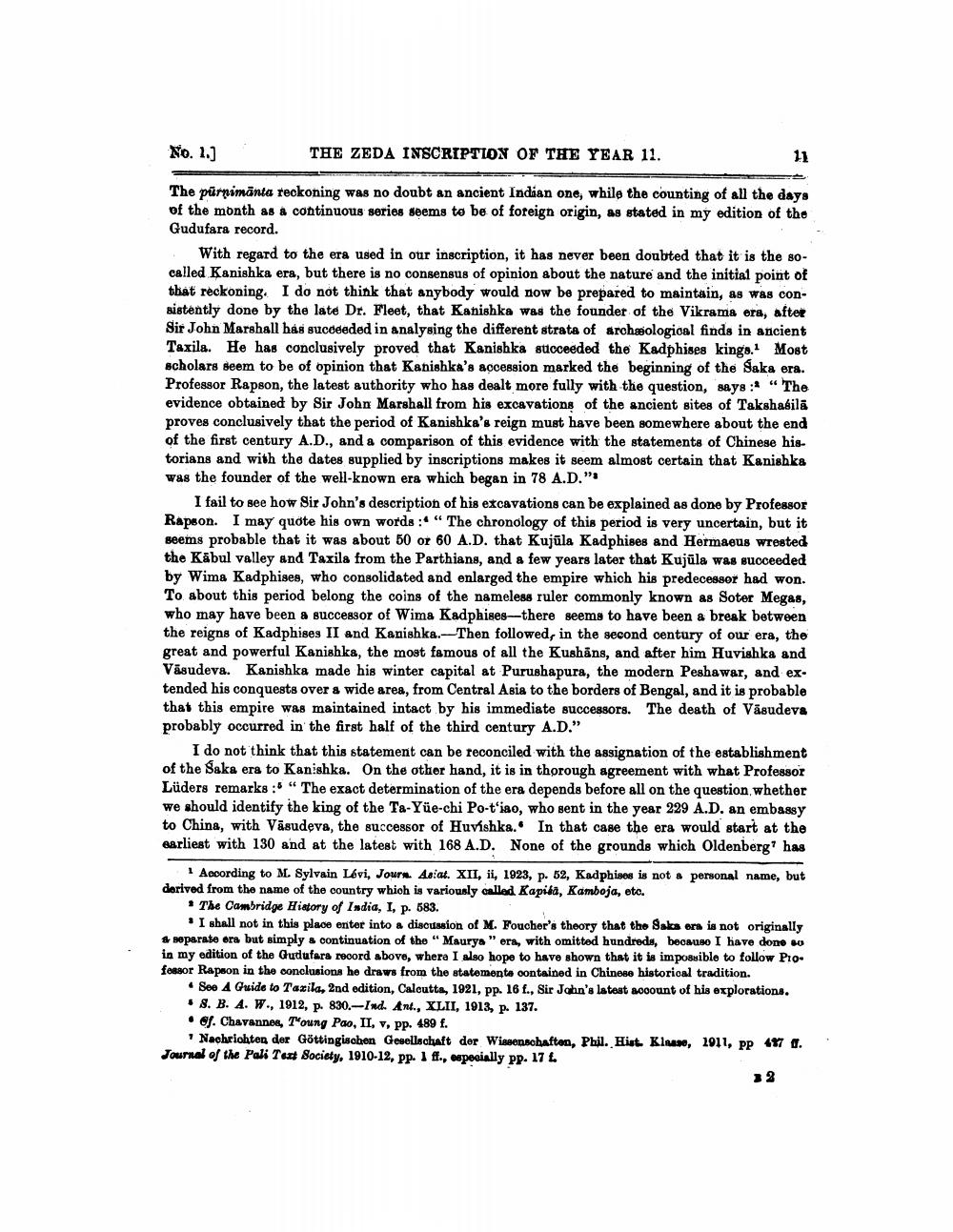________________
No. 2.)
THE ZEDA INSCRIPTION OF THE YEAR 11.
The purnimänta reckoning was no doubt an ancient Indian one, while the counting of all the days of the month as a continuous series seems to be of foreign origin, as stated in my edition of the Gudufara record.
With regard to the era used in our inscription, it has never been doubted that it is the socalled Kanishka era, but there is no consensus of opinion about the nature and the initial point of that reckoning. I do not think that anybody would now be prepared to maintain, as was consistently done by the late Dr. Fleet, that Kanishka was the founder of the Vikrama era, after Sir John Marshall has succeeded in analysing the different strata of archæological finds in ancient Taxila. He has conclusively proved that Kanishka sticceeded the Kadphises kings. Most scholars seem to be of opinion that Kanishka's accession marked the beginning of the Saka era. Professor Rapson, the latest authority who has dealt more fully with the question, says: “The evidence obtained by Sir John Marshall from his excavations of the ancient sites of Takshabilă proves conclusively that the period of Kanishka's reign must have been somewhere about the end of the first century A.D., and a comparison of this evidence with the statements of Chinese historians and with the dates supplied by inscriptions makes it seem almost certain that Kanishka was the founder of the well-known era which began in 78 A.D.".
I fail to see how Sir John's description of his excavations can be explained as done by Professor Rapson. I may quote his own words : “ The chronology of this period is very uncertain, but it seems probable that it was about 50 or 60 A.D. that Kujūla Kadphises and Hermaeus wrested the Kābul valley and Taxila from the Parthians, and a few years later that Kujula was succeeded by Wima Kadphises, who consolidated and enlarged the empire which his predecessor had won. To about this period belong the coins of the nameless ruler commonly known as Soter Megas, who may have been a successor of Wima Kadphises—there seems to have been a break between the reigns of Kadphises II and Kanishka.--Then followed, in the second century of our era, the great and powerful Kanishka, the most famous of all the Kushing, and after him Huvishka and Väsudeva. Kanishka made his winter capital t Purushapura, the modern Peshawar, and ex. tended his conquests over a wide area, from Central Asia to the borders of Bengal, and it is probable that this empire was maintained intact by his immediate successors. The death of Vasudeva probably occurred in the first half of the third century A.D."
I do not think that this statement can be reconciled with the assignation of the establishment of the Saka era to Kanishka. On the other hand, it is in thorough agreement with what Professor Lüders remarks: “The exact determination of the era depends before all on the question whether we should identify the king of the Ts-Yüe-chi Po-t'iao, who sent in the year 229 A.D. an embassy to China, with Väsudeva, the successor of Huvíshka.. In that case the era would start at the earliest with 130 and at the latest with 168 A.D. None of the grounds which Oldenberg' has
1 According to M Sylvain Levi, Jours Asiat. XII, ii, 1923, p. 52, Kadphises is not a personal name, but derived from the name of the country which is variously called Kapida, Kamboja, eto.
* The Cambridge History of India, I, p. 583.
• I shall not in this place enter into a discussion of M. Foucher's theory that the Salas era is not originally # separate ors but simply a continuation of the "Maurys " era, with omitted hundreds, becauso I have done so in my edition of the Gudufara record above, where I also hope to have shown that it is impossible to follow Pło. fonsor Rapson in the conclusions he draws from the statemente contained in Chinese historical tradition.
• See A Guide to Taxila, 2nd edition, Caloutte, 1921, pp. 16 f., Sir John's latest account of his explorations. • 8. B. 4. W., 1912, p. 830.-Ind. Ant., XLII, 1913, p. 137. • of. Chavannes, Toung Pao, II, v, pp. 489 f.
Nachrichten der Göttingischen Gesellschaft der Wissenschaften, Phil. Hist. Klose, 2011, PP 417 . Journal of the Pali Tous Society, 1910-12, pp. 1 ff., especially pp. 17 L




